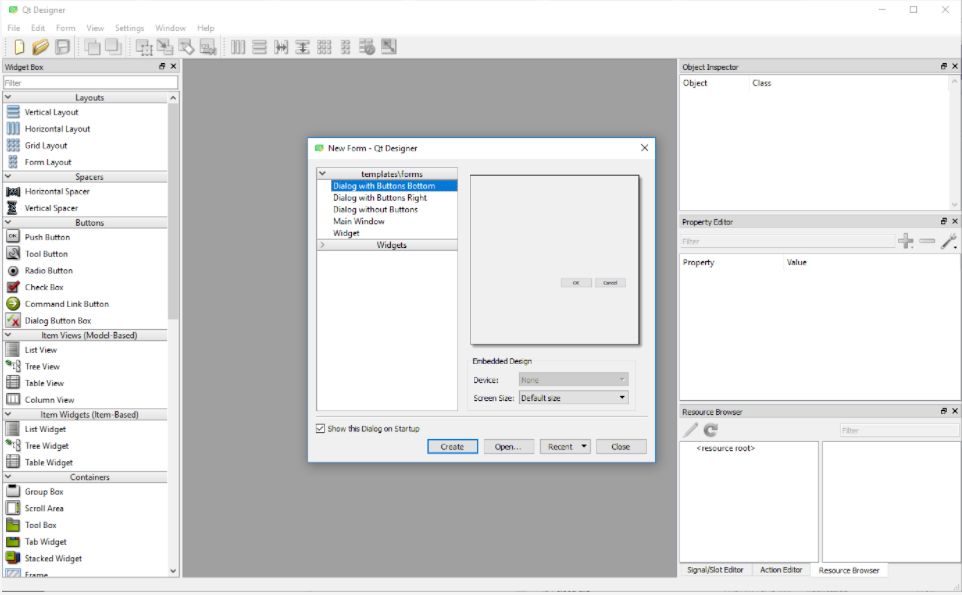Qt Creator Signals And Slots Tutorial
MainSteps:


1. LaunchQt: When you launch Qt Creator, it should look like this.
The Qt signals/slots and property system are based on the ability to introspect the objects at runtime. Introspection means being able to list the methods and properties of an object and have all kinds of information about them such as the type of their arguments. QtScript and QML would have hardly been possible without that ability. It would be possible to have the slots to which the resized and moved signals are connected check the new position or size of the circle and respond accordingly, but it's more convenient and requires less knowledge of circles by the slot functions if the signal that is sent can include that information.
2.Create a new Qt Application: Goto File menu and select New. In the dialog box select Qt4 GuiApplication.
Qt Creator Signals And Slots Tutorial Key
A number of dialog boxes will appearto ask you to specify a name for your project and a location to put it.
... and the modules you want toinclude... for now all you need are the default modules.
After this dialog boxes there will betwo more. Just go with their defaults.
Qt Creator Signals And Slots Tutorial For Beginners
 Qt will then create a bunch of fileslike: MyGUIApp.pro, main.cpp, mainwindow.cpp, mainwindow.h,mainwindow.ui.
Qt will then create a bunch of fileslike: MyGUIApp.pro, main.cpp, mainwindow.cpp, mainwindow.h,mainwindow.ui.3.Design the User Interface:Click on mainwindow.ui to bring up the interface designer.
Using the interface designer add 2push buttons and a text label (by clicking and dragging those itemsfrom the widget palette) to the main window widget.
4.Connect Signals to Slots:Under the Edit menu, select 'Edit signals/slots'- You are now inSignal/Slots editing mode.
Click and drag (and release) from PushButton 1 to somewhere on the main window's widget.
A dialog box will appear asking you toconfigure signals and slots. On the left are signals emitted by a pushbutton. On the right are signals currently received by MainWindow.
We are going to connect the'clicked()' signal to a custom slot of our own called 'button1Pressed()'
Click on the 'clicked()' item on the left. Then click on 'Edit' on theright.
Click on the big green '+' to add anew slot for MainWindow. Type in 'button1Pressed' into the entry boxwhen it appears.
Once you're done, select'button1Pressed()' as the slot to receive the signal 'clicked()'. Thenaccept this by pressing OK.
Your GUI should look something likethis. Notice the red highlighted items showing the signal and slotsthat are connected together.
Repeat the above steps to create aslot to handle Push Button 2 called 'button2Pressed()'
The GUI should now look like this...
5.Add the code to handle the button1Pressed()and button2Pressed() slots: Click on mainwindow.h and insertthe member function declarations code for the slots.
Click on mainwindow.cpp and insert theactual code of the member functions button1Pressed() andbutton2Pressed(). All I want to do in this example is to change thetext in label widget to reflect that I have pressed a button. I amdoing this be explicitly writing: ui->label->setText('Button1');
I could have been more elegant and declared a new signal forMainWindow, perhaps called UpdateLabel(char*) and instead said: emitUpdateLabel. Then I can connect UpdateLabel to the label'sSetText(char*) slot.
6.Compile and Run the program: Clickthe Green Arrow near the bottom left of the screen to get your programto compile and run.
The main window should launch. Click on the two push buttons to seewhat happens to the label.
Oh by the way, notice the filescreated by Qt. Qt Creator automatically created the .pro (project)file. The Designer created the .ui file. And Qt's User-InterfaceCompiler (uic) created the ui_mainwindow.h file.
Also if you look at theui_mainwindow.h file you can see the code generated by Qt for yourwidgets. Notice in particular the connections between the signals andslots.
Quite a frequent problem when working with signals with slots in Qt5, according to my observations on the forum, is the connection of slots in the syntax on the pointers to signals having an overload of the signature. The same applies to slots that have an overload.
Let's take a test class that has overloaded signals.
Qt Creator Signals And Slots Tutorial Free
Here there is a signal, with an overload of the signature. Connect this signal will also be to the slots that are declared in the Widget class, and which also have an overload of the signature.
How it was in Qt4
Within Qt4, everything was solved quite simply by specifying the signature of the signal and the slot in the SIGNAL and SLOT macros.
How it became in Qt5
But in Qt5, when writing in the new syntax of signals and slots, there are some problems. Because you need to make the static_cast of the method signature.
By the way, the new syntax also allows you to connect signals to slots with a smaller signature, as it was in Qt4.
Advantages of the new syntax
And now a stumbling block. Why use the new syntax of signals and slots? I still hear this question from time to time. Especially when people see such terrible castes of signatures.
Qt Designer Signals And Slots Tutorial
- Therefore, I will list potential advantages:The ability to track errors in the connection of signals and slots at the compilation stage, rather than in the runtime
- Reducing compilation time by excluding macros from the code
- The ability to connect lambda functions, it's quite an important bun
- We protect ourselves from errors when we try to connect from the outside to a private slot. Yes!! Yes!! The SIGNAL and SLOT macros ignore the access levels of methods, violating OOP.
Qt Creator Signals And Slots Tutorial Download
In general, for me this is enough, but for you?